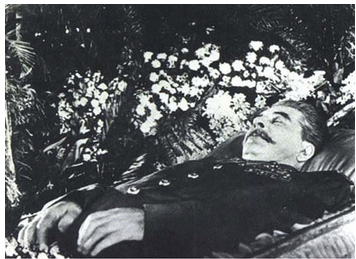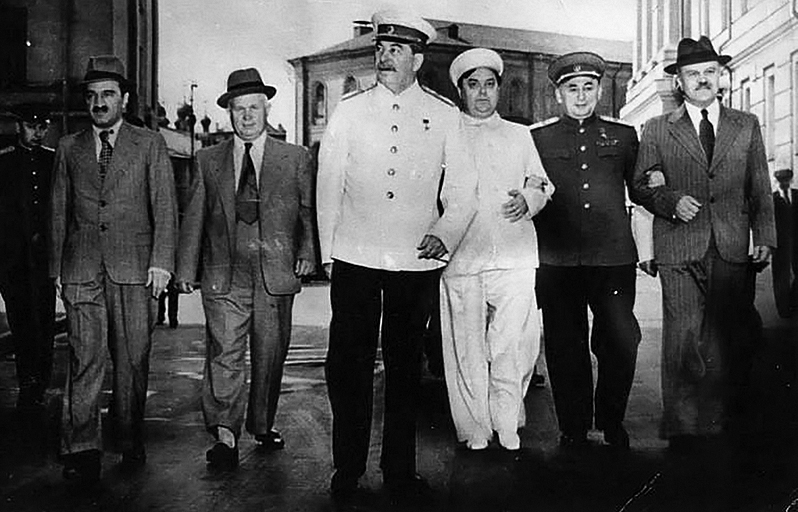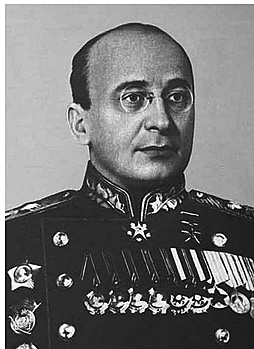
- Articles
The Death of Stalin — The Final Word? by Adam R. Bogart, PhD and Miguel A. Faria, MD
In a series of communications, Dr. Miguel Faria encouraged me to update and revise this conversation both private as well as what has been posted at his website and attempt to resolve some issues that had been left open. I’m not sure that we can do that, since in close to four years after these comments have been written, there have been no new explosive revelations from Moscow that would settle any of these matters definitely. What I can do, however, is state that I have turned into a complete believer of the scenario Dr. Faria proposes for how Stalin died. I say “proposes” only because there are both medical and political components to it, and I think the specifics of both may forever be lost to history.

I’d like to re-examine these components briefly. Looking at the political component, it may be more than just Lavrenti Beria knowing that if he did not get rid of Stalin when he did, his fate and the fate of Stalin’s entire inner circle was sealed. After Stalin’s death, and until June 1953, Beria was the second most powerful man in the Soviet Union, and could easily have become the first, since Georgi Malenkov was hardly suited to hold on to that position. He instituted massive liberal reforms on all fronts, and I do not believe a single person was executed during this period.
Ironically, Khrushchev was able to remove him because he could claim these reforms were destabilizing to the Soviet state. I don’t know that Khrushchev really believed that, but I do know conditions in the USSR returned closer to what they were under Stalin when he ruled, despite his own liberal reforms, and his denunciation of Stalinism. Yet, given Beria’s prior history of extreme violence while in charge of the NKVD/MGB/KGB, can one be too critical of Khrushchev removing him?
So from this short summary of Beria’s actions immediately prior to and then after Stalin died, we can easily believe Beria had enough motive to get rid of Stalin at the time he did, giving us enough “evidence” to believe Dr. Faria is correct. We can probably state with certainty that Beria’s main immediate motive was to save his life and perhaps those of his comrades in Stalin’s inner circle, but we cannot state anything else with certainty. I believe most who are interested in this would like to, but it is not necessary to support the assertion of Stalin’s poisoning.
What about medically? We have a number of different opinions here, all of which are correct in proper context, but we will never know what the precise context was. Yes, we can say part of that context was poisoning, but part of it was also hypertension and hypertensive vascular disease affecting both the heart and brain, and of long standing. The autopsy report is also suggestive enough to make the determination of Warfarin poisoning, but it is far too brief to explain the cause of the hemorrhages found in the myocardium and the bowel. I and others have previously suggested that they may have been agonal, because Cushing’s ulcer is caused by mechanical movement of the vagal nuclei in the brain stem, leading to over-activity of the acid secreting parietal cells of the stomach. It is hard to imagine how one would find hemorrhages elsewhere, if erosion of the mucosa by hydrochloric acid is the mechanism. Similarly, it is equally difficult to see how Cushing’s ulcer would be the cause of Stalin vomiting a large amount of blood, since these ulcers are typically multiple but punctate, and the resultant hemorrhages relatively small. Vomiting of blood is a point strongly in favor of Warfarin poisoning.
Dr. Russell Blaylock could be right if perhaps he was thinking of myocardial injury following intracranial bleeding, since the “Catecholamine storm” after subarachnoid hemorrhage injures the myocardium, so there might be some bleeding and inflammatory cell infiltrate. But would I say that was hemorrhage? I’m not sure. Also, for unclear reasons, prior hypertension is a protectant of the myocardium against catecholamine storms. We know for sure Stalin had that! But, Stalin’s bleed was not thought to be a primary Subarachnoid hemorrhage, was it? Because I think the catecholamine storm is not as important if blood eventually migrates there, which no doubt it often will.
So it looks like everybody might be right, or everybody might be wrong. I think everybody has great points though, and it is interesting to try to readdress them after so much time has elapsed. One thing we can say for sure is that all roads do seem to lead back to murder, in Warfarin form. I cannot doubt it anymore. What all the commentary here illustrates is that while we might have a case of proven poisoning, we sadly will be lacking in the finer details for a long time, if we ever have them. — Dr Adam Bogart
———
Adam, this is an excellent revision, and to start up with I will elaborate on the Beria reforms that you refer to above. I wrote:
Immediately after Stalin’s death on March 5, 1953, Beria moved rapidly to seize power. And almost as suddenly, he became a liberal political reformer. He defended the rights of non-Russian nationalities, such as the Ukrainians and Georgians, vis-à-vis the former Russification policy of Stalin. He admitted that both the Jewish Doctors’ Plot and the Mingrelian affair were concocted by Stalin’s underlings, and had those involved arrested.

Beria then began to decentralize and dismantle the secret police and the Gulag system as part of his broader program of liberalization. He granted amnesty to a large category of Gulag political prisoners. With the repudiation of the Doctors’ Plot, the doctors were released from prison, and the campaign of anti-Semitism was ended. Under Beria, de-Stalinization had begun at a faster pace than would be reestablished later under Khrushchev.
The crisis in East Germany, though, provided the pretext that Nikita Khrushchev needed to challenge Beria’s power in the Kremlin. Malenkov, who had been Beria’s ally, was won over by Khrushchev’s intrigues, as were some important segments of the Russian military, which had come to resent the prominence of Beria and his secret police…
Beria was arrested by military men at a hastily convened meeting of the Presidium on June 23, 1953, only nine days after the East German insurrection was squelched by Russian troops. Khrushchev had been moving feverishly within the Politburo and the military to undermine and gather forces against Beria. Beria was uncharacteristically caught off guard and entered the Presidium without suspecting the plot and the coup that awaited him. Once inside the Presidium, MVD guards (security apparatus successors to the NKVD) who had been posted outside were dismissed by Defense Minister Bulganin and replaced with military troops loyal to General K. S. Moskalenko and Soviet Marshall Georgi Zhukov, who had been brought into the plot. Beria’s fate was sealed.
As for the medical findings there is nothing new under the sun, and we are really at a loss because the validity of the autopsy report itself at least in important points is doubtful. As I mentioned previously:
The Soviet doctors, who signed the autopsy report, may have been reluctant to propound any cause of death other than natural causes. Lavrenti Beria, the head of the secret police, was then the head of the ruling hierarchy in the Soviet Union, and it was he who would have been the number one suspect. The admission of poisoning of Stalin would have led to Beria as a suspect if not the culprit. So poisoning as the cause of death would have been out of the question as the official cause of Stalin’s death in the official autopsy report.
The doctors from the Ministry of Health who signed the autopsy and other medical reports acted cautiously and with political expediency. After all their own lives were in jeopardy:
As much as was possible to put in writing from a political standpoint, without getting their own heads into the repressive Soviet noose (was included in the autopsy report)! They also correctly protected the physicians who treated Stalin. Needless to say, the Doctors’ Plot episode was very fresh in their minds.
The absence of hemorrhages anywhere else but in the left cerebral hemisphere stemming from the deep gray matter would strongly support hypertensive atherosclerosis. But the autopsy findings in conjunction with all the other circumstantial evidence for which I’m indebted — Edvard Radzinsky in his book Stalin, and authors Jonathan Brent and Vladimir P. Naumov in their book Stalin’s Last Crime — The Plot Against the Jewish Doctors, strongly suggest that Stalin was poisoned, providing a modicum of retributive justice for his incredible crimes. So we have to use medical, pathological, physiological evidence as well as political realities. And don’t forget, in the end, Dr. Blaylock stated, “You are probably right — Stalin was poisoned.” so given the available data we are in agreement. I’m only disappointed in that the journalist and historian involved in the article in the Daily Mail (2013) ignored my original article published in the peer reviewed Surgical Neurology International (2011) as well as my response in the same journal (2015) — with an arrogance, disdain, and lack of scholarship that should not be part of the academic world. — Dr. Miguel Faria
_____________________________________
Adam R. Bogart, PhD, is a Behavioral Neuroscientist formerly at the Sanders Brown Center for Aging University of Kentucky, Lexington, KY. Alumnus at the Behavioral Neuroscience Kent State University, Kent, OH. Post-doctoral fellow at the Albert Einstein College of Medicine, Gruss Magnetic Resonance Research Center Bronx, NY. MS Immunology conjointly Adelphi University/Mount Sinai Medical Center New York, NY.
Miguel A. Faria, M.D., is Associate Editor in Chief in socioeconomics, politics, medicine, and world affairs of Surgical Neurology International (SNI). His most recent book is America, Guns, and Freedom: A Journey Into Politics and the Public Health & Gun Control Movements (2019).
This article may be cited as: Bogart, AR and Faria, MA. The Death of Stalin — The Final Word? HaciendaPublishing.com, March 2, 2020. Available from: https://haciendapublishing.com/the-death-of-stalin–the-final-word-by-adam-r-bogart-phd-and-miguel-a-faria-md
Copyright ©2020 HaciendaPublishing.com
1 thought on “The Death of Stalin — The Final Word? by Adam R. Bogart, PhD and Miguel A. Faria, MD”
“Uncle Joe is sick in bed – Rush in blood up in his head – If he can’t walk and he can’t talk – By whom now are the Communists led?”
Interesting different perspective on Stalin’s death. Not sure I buy it, though.
Turner M D (March 16, 2023) Tyrant’s End: Did Joseph Stalin Die From Warfarin Poisoning?. Cureus 15(3): e36265. doi:10.7759/cureus.36265